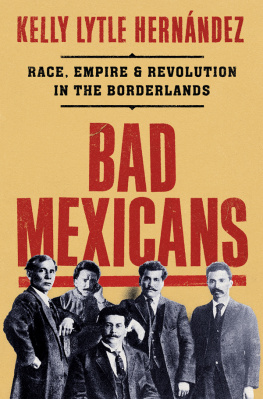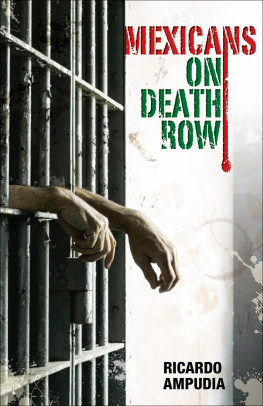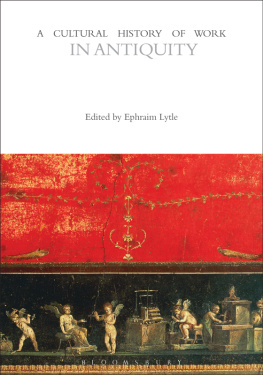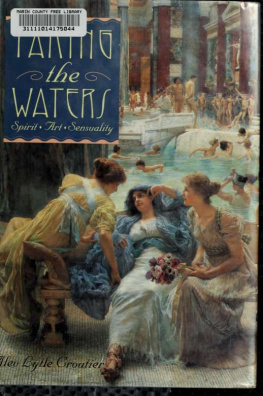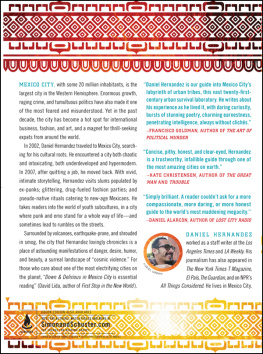Kelly Lytle Hernández - Bad Mexicans
Here you can read online Kelly Lytle Hernández - Bad Mexicans full text of the book (entire story) in english for free. Download pdf and epub, get meaning, cover and reviews about this ebook. year: 2022, publisher: W. W. Norton & Company, genre: Politics. Description of the work, (preface) as well as reviews are available. Best literature library LitArk.com created for fans of good reading and offers a wide selection of genres:
Romance novel
Science fiction
Adventure
Detective
Science
History
Home and family
Prose
Art
Politics
Computer
Non-fiction
Religion
Business
Children
Humor
Choose a favorite category and find really read worthwhile books. Enjoy immersion in the world of imagination, feel the emotions of the characters or learn something new for yourself, make an fascinating discovery.
- Book:Bad Mexicans
- Author:
- Publisher:W. W. Norton & Company
- Genre:
- Year:2022
- Rating:5 / 5
- Favourites:Add to favourites
- Your mark:
- 100
- 1
- 2
- 3
- 4
- 5
Bad Mexicans: summary, description and annotation
We offer to read an annotation, description, summary or preface (depends on what the author of the book "Bad Mexicans" wrote himself). If you haven't found the necessary information about the book — write in the comments, we will try to find it.
Bad Mexicans — read online for free the complete book (whole text) full work
Below is the text of the book, divided by pages. System saving the place of the last page read, allows you to conveniently read the book "Bad Mexicans" online for free, without having to search again every time where you left off. Put a bookmark, and you can go to the page where you finished reading at any time.
Font size:
Interval:
Bookmark:

ALSO BY KELLY LYTLE HERNNDEZ
MIGRA!
A HISTORY OF THE U.S. BORDER PATROL
CITY OF INMATES:
CONQUEST, REBELLION, AND THE RISE OF HUMAN CAGING IN LOS ANGELES, 17711965
BAD MEXICANS
Race, Empire, and Revolution in the Borderlands

Kelly Lytle Hernndez

Copyright 2022 by Kelly Lytle Hernndez
Pages 204206: From City of Inmates: Conquest, Rebellion, and the Rise of Human Caging in Los Angeles, 17711965 . Copyright 2017 by Kelly Lytle Hernndez. Used by permission of the University of North Carolina Press.
www.uncpress.org
Map by Mapping Specialists, Ltd.
All rights reserved
First Edition
For information about permission to reproduce selections from this book, write to Permissions, W. W. Norton & Company, Inc., 500 Fifth Avenue, New York, NY 10110
For information about special discounts for bulk purchases,
please contact W. W. Norton Special Sales at
specialsales@wwnorton.com or 800-233-4830
Book design by Lovedog Studio
Production manager: Lauren Abbate
Library of Congress Cataloging-in-Publication Data is available
ISBN 978-1-324-00437-0
ISBN 978-1-324-00438-7 (ebk.)
W. W. Norton & Company, Inc., 500 Fifth Avenue, New York, N.Y. 10110
www.wwnorton.com
W. W. Norton & Company Ltd., 15 Carlisle Street, London W1D 3BS
CONTENTS

BAD MEXICANS


T HEY LIT THE PYRE AND WATCHED HIM BURN. ANTONIO Rodrguez, a twenty-year-old ranch hand, murdered a white woman, they said. White men from nearby farms formed a posse to track him down, while the other residents of Rocksprings, Texas, some four hundred of them, met at the edge of town and piled kindling at the base of a mesquite tree. The posse soon arrived, with a cowboy in the lead, dragging Rodrguez by a lasso looped around his neck. The mob laughed as they chained Antonio to the tree and doused him in kerosene. Someone threw a match and, thirty minutes later, when Antonio Rodrguez was dead, the residents of Rocksprings returned quietly to town and business was resumed. It was November 3, 1910.
Mexican American journalists in the U.S.Mexico borderlands reported the grisly details of Rodrguezs murder, condemning it as an act of racial terror akin to the lynching of African Americans in the South. Newspapers in Mexico picked up the story. Lynching is not practiced by the blonde Yankee except upon beings whom, for ethnic reasons, he considers his inferiors, fumed the editors of the Mexico City paper El Debate . Another paper dubbed Anglo-Americans the barbarous whites of the north, deriding them as the giants of the dollar but pygmies of culture. There is indignation among Mexicans here over this lynching, reported El Pas .
By November 8, riots had erupted across Mexico. Targeting the considerable number of U.S.-owned businesses and homes, the protestors
Porfirio Daz had ruled Mexico for twenty-seven years. Seizing the Mexican presidency by coup dtat in 1876, the general had thrown open the doors of his country, handing out land and tax incentives to foreign investors. He also guaranteed pliant labor. Tens of thousands of U.S. investors rushed in, ranging from the Rockefellers to one-pick miners, making Mexico the first country where U.S. citizens made significant foreign investment. U.S. citizens soon controlled key sectors of the Mexican economy: railroads, oil, and mining. By 1900, they owned 130 million acres, amounting to one-quarter of Mexicos arable land. And they expected President Daz to protect their interests.
Daz used foreign capital to industrialize the Mexican economy, often with little regard for the rights and wellbeing of Mexicos poorest citizens. When investors bought land claimed by Mexicos rural and Indigenous communities, Daz dispatched soldiers to evict any stragglers or protestors. Most notoriously, when the Yaqui refused to be removed from their homeland, Daz deported the rebel fighters, and their families, to labor camps in the jungles of southern Mexico.
With Daz in charge, investors brimmed with confidence. Even as protestors filled the streets of Mexico after Antonio Rodrguezs lynching, President Taft quipped to his secretary of state, I cannot conceive of a situation in which President Daz would not act with a strong hand in defence [sic] of just American interest.
Still, the protests continued. After a week of conflict in the streets, Ambassador Wilson marched into the presidents office in the National Palace to lodge a complaint. Daz cut him off, informing the ambassador that he had already given the press strict orders to stop any further comments on the anti-American demonstrations, and that one of the journals which had disobeyed these instructions, namely El Debate , had been suppressed.
But the root of the problem was not in Mexico, insisted Daz. The problem was in the United States. There, across the border region, a large number of Mexicans were living in exile and openly planning a revolution against his rule. As Daz put it, the riots in Mexico began only because two of those exiles, Francisco Madero and Ricardo Flores Magn, had taken advantage of the unfortunate affair which happened in Texas to excite young students and men of the laboring classes in order to discredit the government.
Francisco Madero, one of Mexicos wealthiest men, had been in the United States for just a few months. As recently as June 1910, he
Ricardo Flores Magn had been in the United States for six years, agitating for revolt. His followers, known as magonistas , had few resources. They were poor men and women, mostly miners, farmworkers, and cotton pickers, many of them displaced from Mexico when President Daz gave their land to foreign investors. They wanted their land back and they were willing to fight for it. For challenging his rule, the Daz administration dubbed them malos Mexicanos (bad Mexicans).
By 1910, Ricardo Flores Magn and the magonistas had launched a series of attacks on the Daz regime, including four armed raids. When Francisco Madero arrived in the United States and called for a mass uprising against Dazs rule to begin at 6 pm on November 20, 1910, the magonistas vowed to join the fight. By November 16, when Ambassador Wilson met with President Daz, armed men were mustering on the banks of the Rio Grande. Daz told Wilson that a revolution was brewing and only the U.S. government could stop it. Unless the American Government prevents these men from making an open revolutionary propaganda against the Mexican Government... a more serious disturbance might be expected, warned Daz.
U.S. authorities were already monitoring the situation. In Texas, federal agents tailed Francisco Madero, who, they confirmed, was acquiring trainloads of guns and smuggling them across the border. But, according to most U.S. authorities, Maderoa political reformer who was popular among Mexicos middle and upper classeswas not a threat to U.S. interests. After decades of corrupt elections, these wealthier Mexicans sought to oust Daz from power and restore democratic rule, but they hardly questioned the economic arrangements of the Daz regime. As Ambassador Wilson put it, a Madero administration U.S. agents did not arrest Madero or his supporters, known as maderistas .
Font size:
Interval:
Bookmark:
Similar books «Bad Mexicans»
Look at similar books to Bad Mexicans. We have selected literature similar in name and meaning in the hope of providing readers with more options to find new, interesting, not yet read works.
Discussion, reviews of the book Bad Mexicans and just readers' own opinions. Leave your comments, write what you think about the work, its meaning or the main characters. Specify what exactly you liked and what you didn't like, and why you think so.

